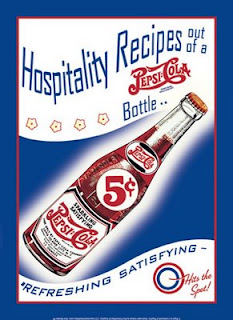 The history of this company began in the early 1890's in North Carolina by Caleb Bradham, a pharmacist from New Bern and offered to customers as a medicine for dyspepsia, began with the name "Brad's Drink." In 1898 the beverage was renamed Pepsi-Cola in 1902, Caleb Bradham requested registration of the mark and founded the company with 97 shares of stock and registered as a trademark on June 16, 1903. Bradham knew from the outset that the marketing aspect would be the basis for success and so during its first year it spent $ 1,900.00 dollars in advertising (very large sum when you take into account that it had sold just 8,000 gallons of concentrate).
The history of this company began in the early 1890's in North Carolina by Caleb Bradham, a pharmacist from New Bern and offered to customers as a medicine for dyspepsia, began with the name "Brad's Drink." In 1898 the beverage was renamed Pepsi-Cola in 1902, Caleb Bradham requested registration of the mark and founded the company with 97 shares of stock and registered as a trademark on June 16, 1903. Bradham knew from the outset that the marketing aspect would be the basis for success and so during its first year it spent $ 1,900.00 dollars in advertising (very large sum when you take into account that it had sold just 8,000 gallons of concentrate). In 1905, Caleb Bradham it built its first bottling plant. By 1907 they had 3 more plants with annual sales of 100,000 gallons of concentrate (in two years sold twelve times more concentrated). Both the First World War, as the Depression of 1929 Pepsi life almost extinguished, and Caleb had to return to their previous occupation: pharmacist.
Charles Guth in 1931, then President of the Society of sweet LOFT bought the trademark.
After several experiments and five years, he decided to bottle Pepsi in used bottles of beer 12 ounces, but contains twice as common cola, had to charge twice, ie, ten cents and therefore the consumer is reluctant to pay that price, why Guth decided to sell the product to five cents, giving consumers good reasons to consume the product.
In 1936, Pepsi could profit of about 2 million dollars.
In 1938 he was appointed Company President Walter Mack, who regarded advertising as the key business and transformed the Pepsi company in a modern trading.
In 1940, made history when it aired the first national "Jingle" advertising. Its title, "Nickel Nickel", referring to its price (5 cents). "Nickel Nickel" was an event, translated by up to 55 different languages.
 With the advent of the Second World War, the United States Government was the need to ration sugar, and this seriously hurt the sales of Pepsi. On the other hand, the slogan "twice for the same five cents" ceased to be effective for the end of World War II, and sales went through the floor.
With the advent of the Second World War, the United States Government was the need to ration sugar, and this seriously hurt the sales of Pepsi. On the other hand, the slogan "twice for the same five cents" ceased to be effective for the end of World War II, and sales went through the floor. In 1949 he became President of Pepsi Al Steele remarkable and capable leader. It changed everything: introduced a stylish bottle, created a marketing department, presented the Pepsi as a refreshing drink, light, low in calories, and did something more important: that the bottlers dip into their savings and mortgaged their homes to invest in the business, what was that in 1959 there were more than 200 bottlers.
Pepsi began to be a real challenge for Coca Cola.
In 1963 he becomes president of Pepsi Donald M. Kendall and with it the advertising agency BBDO (Batten surname initials, Baston, Durstime and Osborn) who to date remains the responsible creative image of Pepsi. Between the years 1963 (when Kendall took over the company) and 1986 (when he retired) made a corporation that is ranked 41 among the 500 largest companies in the United States.
In 1965 he created Pepsi Co., the result of the merger of Pesi-Cola and Frito Lays.
To create a climate that would attract people with talent and entrepreneurship, he moved the headquarters was in New York, the rural population of Purchase (now the home of The Pepsi Corporation Co.) in County Westhester.
 In 1984, pop singer Michael Jackson signed a multimillion-dollar advertising contract with Pepsi, with reciprocity for the announcement of the Victory Tour sponsored by Pepsi. Two scenes were taped ad with Jackson dancing with a group of neighborhood children at a concert.
In 1984, pop singer Michael Jackson signed a multimillion-dollar advertising contract with Pepsi, with reciprocity for the announcement of the Victory Tour sponsored by Pepsi. Two scenes were taped ad with Jackson dancing with a group of neighborhood children at a concert. In 1986 when he handed over command to Wayne Calloway, Pepsi Corporation, which owned and Restaurants Frito Lay and Pizza Hut and Taco Bell selling about $ 9,000 billion a year.
Pepsi Co. is currently among the most successful consumer products companies in the world with annual revenues of more than 30.000 million and more than 480,000 employees.






No hay comentarios:
Publicar un comentario